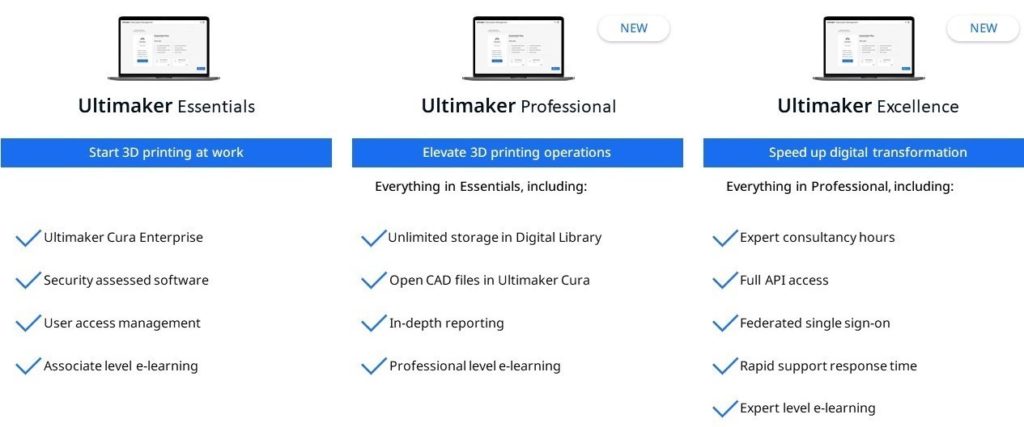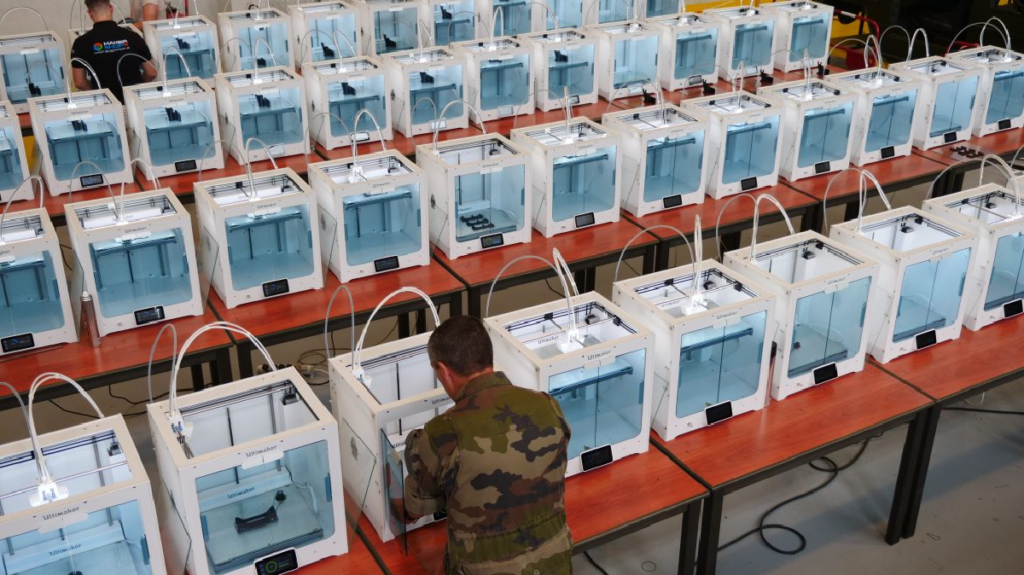Desktop 3D printing company Ultimaker has further broadened its ecosystem software strategy with the release of two new bundles: Ultimaker Professional & Ultimaker Excellence. They will reinforce the company’s path to becoming a platform. Ultimaker’s Essentials package will be available with all new Ultimaker 3D printers. Ultimaker will tie in products from third parties, certify them, and provide API access. The overall vision of the Ultimaker platform is that it “focuses on the end-to-end workflows, from enabling engineers to collaborate on a design, to storing applications and printing on demand.”
The company, therefore, wants to tackle the plumbing on the whole idea to print toolchain. Ultimaker’s new commercial package, Professional, allows people to collaborate and share files. There’s no versioning yet, but users can share notes and work together. They can store files in the Digital Library and open native CAD files in Cura. There is also more reporting and learning resources.

With Ultimaker Excellence, you have single sign-on access management, API access, and better support. You also have better analytics and can look at the utilization of all of your printers or single systems. You also get a set number of consulting hours from Ultimaker Data, Software or Application engineers to build custom functionalities for you. I think that this is a great idea, since it will lead to a greater understanding of customer needs and make the software more sticky.

“Ultimaker is uniquely positioned as a leader in the professional 3D printing segment, delivering both hardware and software solutions. The platform is the evolution, elevating our current capabilities and enabling our partners and diverse ecosystem to deliver a seamless, innovative, and futureproof customer experience. Our belief is that all businesses: small, medium, and large, should have the opportunity to take advantage of the platform and ecosystem. This allows them to remain flexible and productive in a volatile world,” said Ultimaker’s new CEO Jürgen von Hollen.
This is all being announced at today’s Ultimaker Transformation Summit Conference. It all makes sense, of course, and this kind of tooling will really make life easier for large- and medium-sized companies who wish to roll out 3D printing within the confines of their IT infrastructure.

Amid the pandemic, the French Army established a 50-printer Ultimaker farm to 3D print spare parts.
In advance of this announcement, we interviewed Paul Heijmans, SVP of Software at Ultimaker. He confirmed that the firm is a platform company and wants to continually make its ecosystem better. Heijmans’s team extensively worked with its users to develop the software.
“We spoke with 27 customers and validated our work and their problems along with them,” he stated.
The drive to create this software had to do with how difficult it was for customers to share files across their internal network and how hard it was for them to collaborate with 3D files using existing tools, such as Sharepoint.
“We also really wanted to add value for customers—really wow them with ‘yes, that’s the feature that I’ve always needed.’ It was really important to work together with them to really find what was important to them,” Heijmans said. “We wanted to really enable the Digital Factory and let people print from anywhere and let them use a library to do so. Colleagues can work together on projects, and tag and comment on work. Files can then be saved to the Library. We’re also showcasing increased collaboration with Fusion 360.”
Everyone can use the packages in 30-day trials to evaluate them. A platform strategy on top of an ecosystem of partners can be a very valuable thing for all participants. The platform company of course reaps the financial rewards of corralling other vendors and customers onto its platform. Vendors get access to customers and, hopefully, their own revenue streams, while clients get better software tailored to their needs. For example, Shopify has over 800,000 stores and they have generated 25 million app installations by Shopify customers. Salesforce apps are pulling in well over $1.5 billion a year. You can see how having others work on making your platform better could be very compelling from a strategic viewpoint. This also affords you much more ongoing revenue from people using your services. All in all, now many people will want you to be the default platform for this industry. In executing a platform strategy, Ultimaker can also use its heft to outmaneuver smaller rivals.
On the downside, this kind of platform moves the firm further away from its open-source roots. Cura became the most well-used slicing software out there just because it was open source, it was easy to use, and worked on all gantry FDM printers. There was perhaps a path out there whereby the company could have built its entire stack on top of open source software and propagated this directly with a service offering on top of it. All in all, however, this seems like it could be a useful tool for many corporate customers and perhaps I’m just being a tad wistful.
Subscribe to Our Email Newsletter
Stay up-to-date on all the latest news from the 3D printing industry and receive information and offers from third party vendors.
Print Services
Upload your 3D Models and get them printed quickly and efficiently.
You May Also Like
Consolidation in AM: How 2025 Is Shaping the Industry’s New Normal
The first half of 2025 has been marked by a clear shift in the additive manufacturing (AM) industry. Companies are no longer just focused on developing new tech by themselves....
Etsy Design Rule Change Reduces Selection of 3D Printed Goods
Online marketplace Etsy has implemented a rule change requiring all 3D printed goods on the site to be original designs. The update to the site’s Creativity Standards states, ¨Items produced using...
U.S. Congress Calls Out 3D Printing in Proposal for Commercial Reserve Manufacturing Network
Last week, the U.S. House of Representatives’ Appropriations Committee moved the FY 2026 defense bill forward to the House floor. Included in the legislation is a $131 million proposal for...
Transforming From Tourist to Native: Duro CEO Michael Corr Explains Why the Company Rebuilt its PLM Software on AI
In these early innings of the AI boom, many market analysts have expressed concern that AI spend has gotten too far ahead of the technology’s proven ability to deliver significant...
































